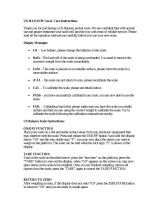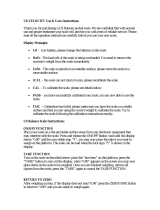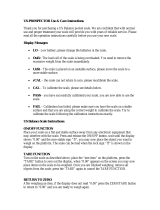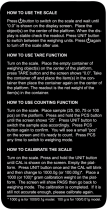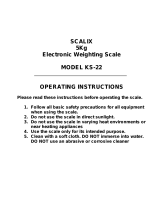Page is loading ...

Operating Instruction
METTLER TOLEDO
High-Capacity PM-Scales
0.0
g

2
Thank you very much for the confidence you have shown in our products by choosing a METTLER TOLEDO precision scale. To obtain complete
satisfaction from your scale, it is essential that you read through these operating instructions carefully.
These operating instructions apply to scales of the PM series with a weighing range between 11 and 32 kg. Although the operating procedures for
these scales are identical, differences exist regarding the weighing range and the readability accuracy.
Preparation Set line voltage / Choosing the location page 4
Mounting the weighing platform / Levelling the scale page 5
Operation Controls / Connections / Display page 6
METTLER DeltaTrac / METTLER DeltaRange page 7
Switching display on/off page 8
Simple weighing and taring page 9
Symbols page 10
Menu Overview page 11
Calibrating page 12
Adapting the scale to the type of weighing (weighing process adapter) page 14
Adapting the scale to the ambient conditions (vibration adapter) page 15

3
Configuring Overview page 16
Configuration example page 18
Standard setting and printout page 20
Scale operating settings page 22
Unit selection, applications, status displays page 24
Adaptation to external equipment for data exchange page 26
Securing configuration page 28
Applications Overview page 30
Weight unit selection page 31
Piece counting page 32
Plus/minus and percent weighing page 34
Animal weighing / Weighing in extremely unsteady or vibrating surroundings page 36
Print/transfer command page 37
What if ... Troubleshooting page 38
Miscellaneous Change line voltage/fuse page 40
Change protective cover / Cleaning page 41
Glossary of special terms page 42
Technical data Overview of the PM balance and scale families page 43
Technical data for individual models page 45
General technical data page 48
Standard equipment page 49
Weighing ranges in secondary units page 50
decimal places in secondary units page 51

4
30°
20°
10°
0°
Preparation
100 V
115 V
200 V
230 V
Set line voltage
Before switching on the scale, ensure that the line voltage setting matches the local power supply.
The balance/scale has already been set in the factory to the correct line voltage for your country. The
balance/scale may be operated only when connected to a supply network with a PE conductor.
Select the proper location
For best results choose a suitable location for your scale.
A firm, vibration-free location as horizontal as possible
Avoid exposure to direct sunlight
No extreme temperature changes
No draft
Despite a possibly unfavorable location, your scale can still produce accurate weighing results:
In this case you should adjust the vibration adapter accordingly. For procedure, refer to section “Menu”.

5
7
0.0
g
6
0.0
g
10
11
20
40
Mount the weighing platform ...
Install platform support 11 with all
four pins sitting on rubber grom-
mets 40; then place weighing
platform 10 on platform support
11; connect power cable 20.
... and now level the scale
After each relocation of the scale,
repeat levelling procedures.
For this purpose adjust bubble in
level indicator 6 with the two
levelling screws 7.
Preparation

6
G B N TAZ
31e
31f
31a
31 31b 31c 31d 35
343332
8.8.8.8.8.8.8
10
0
.0
g
9
2
9 5 6 7 8 9
341
Operation
Control elements and connections
1 Control bar (On / Menu / Re-Zero)
2 Off key Ø
3 Function and switch key f
4 Print key ∏
5 Connector for data interface
6 Connector for METTLER TOLEDO GM instruments
7 Fuse holder (with spare fuse)
8 Power socket
9 Screw feet (level adjustment)
10 Level indicator
Display
31 Status indicators
31 a Vibration adapter
31 b Weighing process adapter
31 c Weight status
31 d Automatic zero correction
(Autozero)
31 e Special status of digital display*
31 f Stability control
32 Digital display
33 Units
34 DeltaTrac (dynamic graphic indicator and dispensing aid with
60 radial segments)
35 Tolerance limits
* indicates calculated quantities such as mean values or values multiplied by
constants, as well as data entered via the interface

7
With absolute weighing, subtractive weighing, weighing-in and
formula weighing, the dynamic display indicates the
weighing range used up and that still remaining.
With the aid of METTLER DeltaTrac you can check fill quanti-
ties and determine deviations from a definable target weight in
percent.
You can always see the tolerance limits with correct signs,
as well as positive or negative deviations (see “Applications”).
The METTLER DeltaTrac
This dynamic graphic indicator with 60 radial segments is incorporated in all scale models. METTLER DeltaTrac shows you a graphic
representation of the numerical values shown in the digital display.
Note: The 10 times more accurate fine range also remains
effective for backweighing.
When used together with METTLER TOLEDO Pacs, the METTLER DeltaTrac can also perform additional functions (see booklet “Applications –
Technical data – Accessories”).
METTLER DeltaRange
®
balances ...
... include a fine range with 10 times the normal accuracy. Briefly pressing the control bar (taring) will activate DeltaRange anywhere through-
out the entire weighing range.
10 times
more
accurate
fine range
Coarse range Coarse range
Fine range
Weighing range
Operation

8
Switch on display ( display changes automatically)
Display switched off (standby)
Briefly press control bar; all display segments light up briefly
(automatic system and display check)
Software No. (e.g. 10.40.00, for information only)
Display subsequently indicates zero (weighing mode). The number of decimal places depends
on the readability of your scale model as well as the selected weight unit.
Note: Should a power outage occur, the display will indicate -OFF- immediately the power is restored. You should then briefly press the control
bar (also consult “What if ...”).
Switch off display
Weighing mode
Press the Ø key; the display fades. The electronics remain live as long as the power cable
is connected (standby). Thus, the scale is always ready for operation; no warm-up time requi-
red.
.
PCS
Stk
G
N
k
t
k
g
o
t
/
%
G B N TAZ
10.40.00
-.-.-.-.-.-.-
9
8.8.8.8.8.8.8
-.-.-.-.-.0.0
OFF
9
-.-.-.-.-.0.0
Operation
▼

9
Simple weighing
Caution: Before the scale is used for the first time, it must be calibrated (see “Calibrating” in section “Menu”).
Weighing mode
Load weighing sample
Wait for stability and read result
(stability is attained when the stability detector fades)
Taring ( ▼ display changes automatically)
Weighing mode
Load an empty container or package
Brief pressing of control bar initiates taring cycle
The container or packing has now been tared
The weighing range minus tare weight is now available for weighing-in
Note: The stability detector can be switched off during taring by pressing the control bar twice. It is then possible that the display does not
show exactly 0.0 g. The foot or hand switch from the accessories offers the possibility of external taring.
..
9
..
9
9
16530.7
15354.3
-.-.-.-.-.0.0
- - - - - -
-.-.-.-.-.0.0
9
1
..
1800.0
9
-.-.-.-.-.0.0
9
Operation
Tare

10
Introducing the symbols
Use the following example to familiarize yourself with the key symbols. Switch on the display and remove weight from weighing pan. Now try to select
and change the weighing process adapter 31b.
Note: If the display automatically returns to zero (weighing mode) 3 seconds after the control bar was last pressed,
simply begin the procedure again.
Have you adjusted the status display so that the “drop symbol” is shown on the left of the display? If your first attempt
was unsuccessful, try again. You will find further information regarding the weighing process adapter and much more in
the following sections.
.
-.-.-.-.-.0.0
9
.
c
31b
CAL Int
* With scales without a built-in calibration weight (PM ... -N), “-CAL-” appears.
Press control bar ...
... keep depressed...
... release!
Briefly press control bar!
Symbols
Press
control bar
briefly
Press and hold
control bar
until required display appears
Display changes automatically
Operation
*

11
Menu
* With scales without a built-in calibration weight (PM ... -N), “-CAL-” appears.
Menu
*
We distinguish between two levels of software. The first, simpler level, we call the Menu. It can be activated by pressing and holding the control
bar. The second software level is called the Configuration file and is described in detail in the section “Configuring”.
When the Menu is activated, you can ...
... calibrate your scale ...
... use the weighing process adapter to set the weighing modes or the weighing sample, and
... use the vibration adapter to adapt the scale to the ambient conditions.
You can select the menu from the weighing mode. Switch on display and remove load from weighing platform. Then press
control bar (and keep depressed): The Menu sequence starts. After the third menu step the scale returns to the weighing mode.
Now release the control bar.
Note: If you have selected the menu step “Weighing process adapter” or “Vibration adapter” and do not press the control bar
for 3 seconds, your scale will return automatically to the weighing mode. However, the actual settings are stored (the same
applies if you return to the weighing mode by pressing and holding the control bar).
c
..
CAL Int

12
Before the scale is used for the first time, it must be calibrated (to take the acceleration due to gravity into account).
Caution: To obtain accurate results it is advisable to connect the scale to the power supply 30 minutes before calibrating.
Automatic calibration with PM ... -K
Menu
..
9
0
9
c
-.-.-.-.-.0.0
9
..
-.
-.
-.-.-.-.-.-
.. ...
-.-.-.-.-.-.-.-
CAL Int
-.-.-.-.-.-.-
CAL Int
CAL Int
-.-.-.-.-.0.0
9
Start calibration with display switched on by pressing and holding the control bar (weighing mode,
display zero with empty weighing platform).
Release control bar when “CAL Int” is displayed.
The calibration runs automatically.
Note: You can also trigger the calibration via the serial interface with the command “CA” (see
operating instructions “Bidirectional data interface of the PM balances”).
After the calibration, the scale automatically returns to the weighing mode.

13
Calibrate with an external calibration weight with PM ... -N
Before using the scale for the first time, it must be calibrated (taking gravity into consideration).
Caution: For exact results it is advisable to connect the scale to the power supply 30 minutes before calibrating.
Start calibration with display switched on by pressing and holding the control bar (weighing
mode, display zero with empty weighing pan).
Release control bar as soon as “–CAL–” appears in display.
Required calibration weight, e.g. 4000.0 g flashes.
Place required calibration weight on scale.
Prompt to remove weight.
Remove weight from scale.
Now the scale is calibrated.
Menu
-.-.-.-.-.0.0
9
.
15
.
-CAL -
-.-.-.-.-.-.-.-
... .
00
..
4000.0
.
9
-.-.-.-.-.-.-.-
... .
00
..
400
0.0
9
-.-.-.-.-.-.-.-
-.-.-.-.-.0.0
9

14
Adapt your scale to the type of weighing (weighing process adapter)
Access With this adapter you will optimize the display speed of the digits as a
function of weighing mode: For instance, for fine dispensing of powders
even the last place of the digital display must be continuously recogniza-
ble. This is not the case for absolute weighing; the adapter thus
suppresses the display during the weighing process. The result with all
decimal places will appear only when it is stable.
Weighing process adapter
Adjustments Weighing process Remarks
Fine dispensing (weighing-in) of fine For slow addition of the sample, all decimal places of the display
powder or small quantities of liquids are available. The weight increase can thus be followed easier.
Universal Standard setting. With DeltaDisplay -on-, the last decimal place is
suppressed in coarse dispensing, see page 23.
Absolute weighing In this setting, you can rapidly check a weight. Only the final result
appears in the display. “- - - - - -” is displayed during the unstable phase.
Animal weighing or weighing in extremely Your scale is operating in the animal weighing mode, e.g. movements
of a live animal do not influence the display. The measurement values
are averaged during a certain time period and subsequently indicated on
the display.
Starting of measuring cycle and setting of measuring time are explained
the section “Applications, animal weighing”.
Weighing mode
c
.
-.-.-.-.-.0.0
9
.
CAL Int
Menu
*
* With scales without a built-in calibration weight (PM ... -N), “-CAL-” appears.

15
... as well as to the ambient conditions (vibration adapter)
Access Under vibration-free conditions adjust the adapter to obtain results
within the shortest possible time. However, if you are operating in an
environment with severe vibrations or drafts, adjust the adapter to
obtain reliable results, even under adverse conditions.
Vibration adapter
Adjustments Weighing environment Remarks
Very quiet and stable With this setting your scale operates very fast (short weighing
cycle), but the scale is relatively sensitive to ambient dis-turbances.
Normal Standard setting
Unstable, e.g. draft or Your scale is not sensitive to external disturbances, however,
strong building vibrations its operation is slowed down.
Weighing mode
c
-.-.-.-.-.0.0
9
..
CAL Int
Menu
*
* With scales without a built-in calibration weight (PM ... -N), “-CAL-” appears.

16
Special requirements need special settings within the configuration file
Your scale has been factory-set to a standard configuration, i.e. the settings in the configuration file correspond to the most common user re-
quirements. If you wish to change these settings to meet special requirements you must access the configuration file and change the settings
according to your needs. The configuration file is divided into four sectors, in which you can change the following settings:
Standard setting and record printout
Resetting to standard configuration
Printout of balance specification values and actual configuration (printer connected)
Setting scale operating parameters
Changing stability detector (four settings)
Reducing readability
Switching off METTLER DeltaDisplay
Switching off automatic zero correction
Configuring
rESEt
yES
LISt
sCALE
ASd
d.
dd.
AZ

17
Unit selection, applications etc.
Selection of basic unit
Selection of second unit and applications
Switch on status displays
Adapting to peripherals for data interchange
Transmission mode
Baud rate
Parity
Pause between data transfers and handshake
Suppression of certification symbols in data transmission
Please see the following pages for more information on the individual setting possibilities.
Note: Short-form operating instructions are enclosed with this operating manual and show the configuration file with all possible settings.
These short-form instructions are intended for use as an overview aid in your day-to-day work.
Unit
Unit 1
Unit 2
use
I-FACE
s
B
P
PAUSE
AU
Configuring

18
Configuring - a quick introduction
Access
Start from standby, i.e. display switched off.
Now press control bar and release only
when display shows –Conf–.
Display now automatically changes over to –
Reset–.
Selecting sectors
The 4 sectors can be selected by briefly
pressing the control bar.
Note:
The –End– display between the sectors
–I-Face– and –Reset– indicates the end
of the four sectors.
Selecting adjustment
For instance in sector –Unit–:
Keep control bar depressed until the desired
selection is displayed (e.g. –Unit 1–).
-
------
-ConF-
rESEt
rESEt
SCALE
Unit
I-FACE
End
Unit
Unit 1
g
Configuring

19
Have you found the setting –Unit 1–? If not, switch off the display by pressing the Ø key.
Then restart by accessing the configuration file. This time it’s sure to work.
Change setting
e.g. from –g– (gram) to –lb– (pound):
Briefly press control bar several times until pound (lb)
appears in display.
Return to weighing mode
After completing your configuration keep control bar depressed until
zero indication appears (weighing mode). The effective settings are
now stored, and you can proceed with your weighings.
Note: If you release the control bar at –End– (each sector is termi-
nated with –End– ) and then press briefly, you will return to the start
of the corresponding sector (e.g. –Unit–).
Unit 1
lb
Unit 2
g
Auto
End
0.0
9
If, after making these changes, you would like to return to the standard configuration, please turn to the next page. The following pages also
tell you everything you wish to know regarding the individual setting options. A general overview of the configuration file is available from the
enclosed short-form operating instructions.
Configuring
Unit 1
g
Unit 1
lb
Press briefly x times

20
-
------
-ConF-
rESEt
Standby
Configuring
Standard setting and record printout
Access
Symbols
Control bar
press
briefly
Press and hold
control bar
until required display appears
Display changes automatically
Important
Return to weighing mode always by pressing and holding the control bar until zero is dis-
played.
If you do not press the control bar for 40 sec, the scale will automatically return to the
weighing mode.
/

